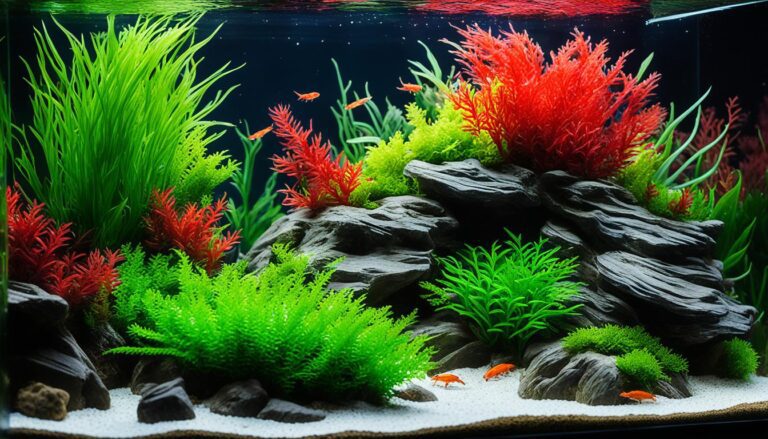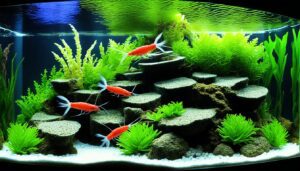I’m totally captivated by the colorful underwater world, especially when it comes to Crystal Red Shrimp. Known scientifically as Caridina cf. cantonensis ‘Crystal Red’, these tiny creatures add a burst of red and white to any aquarium, making it feel more alive. Taking good care of them is super important to keep them healthy and thriving, and getting the water conditions just right is key.
Crystal Red Shrimp usually live around 1.5 years in a tank and originally come from Southeast Asia. Whether you’re new to shrimp keeping or have been at it for a while, setting up the right environment is crucial. While a 5-gallon tank can work for a small group, I’ve found that a 10-gallon tank is even better—it makes it easier to maintain the perfect water conditions.
I put a lot of effort into making my tank resemble their natural habitat. For these shrimp, the water pH should be between 5.8 and 7.4, and the temperature needs to stay between 62-76°F (16.5-24.5°C). If you’re thinking about breeding them, a larger tank will definitely improve your chances of success.
These days, finding Crystal Red Shrimp for sale is pretty straightforward. You can pick them up from specialized stores or order them online, with places like The Shrimp Farm being a good option to check out. Keeping these shrimp is a fun and rewarding challenge, and their vibrant red and white colors are a daily treat for any aquarium lover.
Introducing the Crystal Red Shrimp in Your Aquarium

Welcome to the world of Crystal Red Shrimp. These creatures bring life and color to your aquarium. It’s important to know about their needs and which fish they can live with.
The Origins of Caridina cf. cantonensis ‘Crystal Red’
The Crystal Red Shrimp come from Southern China. They were bred from Caridina shrimp for their colors. Now, they’re loved worldwide for making tanks elegant.
Popularity and Aesthetic Appeal
The Crystal Red Shrimp are very popular. Their red and white colors stand out. They are small and peaceful, perfect for detailed aquariums.
Deciding Between a Species-Only Tank or a Community Setup
Think about if you want only crystal red shrimp or other fish with them. A tank just for them is easier to manage. You can better watch their health and breeding.
Adding calm fish like Pygmy Cory Catfish can be nice, too. Make sure all the fish like the same water conditions. This helps everyone in the tank be stress-free.
Whether it’s just shrimp or a tank with friends, keeping them healthy is crucial. Take care of their water and feed them right. Picking the right fish to live with is also key. Your Crystal Red Shrimp will do great with care and the correct setup.
Size Expectations and Growth Patterns
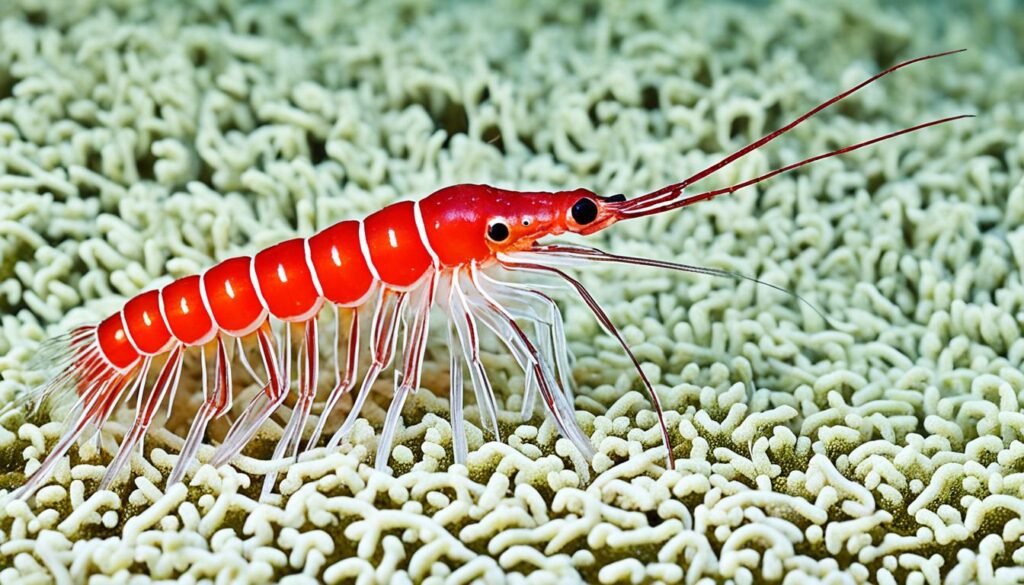
Understanding the size of Crystal Red Shrimp is crucial whether you’re a newbie or an experienced aquarist. These shrimp are pretty small—males typically reach about 1 inch, while females can grow a bit larger, up to around 1.5 inches. Their compact size makes them perfect for both small and larger tanks.
Their growth rate is another important factor to consider. Crystal Red Shrimp grow quickly and can start breeding at around 70 days old. As juveniles, they molt almost daily, but this slows down to every 3 to 4 weeks as they mature.
Molting is a key part of their growth process, where they shed their old shell to make room for a new one. During this time, the shrimp are quite vulnerable and tend to hide until their new shell hardens. Maintaining good tank conditions—like clean water, the right temperature, and proper food—is essential to help them through this delicate phase.
Knowing these details about Crystal Red Shrimp is key to keeping them healthy and content in your tank. They truly add a splash of beauty and vibrancy to any aquarium setup.
Ideal Water Conditions

Making sure the crystal red shrimp water conditions are right is crucial for their well-being and color. These shrimp do best when their water is just so. Let’s look at what makes the perfect crystal red shrimp water.
pH, Temperature, and TDS Requirements
Crystal Red Shrimp like their water a bit acidic and soft. It’s best to keep the pH between 6.0 and 6.8. This helps them live longer and breed better. The ideal temperature is between 68°F to 74°F for their comfort. Also, keeping Total Dissolved Solids (TDS) between 100-150 ppm is key for their health.
Managing Nitrate and Ammonia Levels
It’s vital to keep ammonia and nitrite at 0 ppm because they can be deadly. Nitrates should be near 0 ppm and never over 20 ppm. High levels can cause disease. Do water changes of 10% to 15% every two weeks to keep crystal red shrimp parameters right.
Stability in Water Parameters: Key to Shrimp Health
Keeping water parameters stable is a must for the shrimp’s survival and breeding success. Sudden changes can stress them out, making them get sick easily. Check the water regularly and adjust slowly to keep things balanced.
To wrap it up, knowing and keeping the ideal crystal red shrimp water conditions is key. With careful checks and maintaining stable conditions, your shrimp can be healthy and vibrant.
Creating a Suitable Tank Setup for Crystal Red Shrimp

Getting the tank setup right for crystal red shrimp is key. My goal is to help you make a space that keeps these shrimp healthy. We will cover everything from how big the tank should be to the best type of ground and filters to use.
Finding the Right Tank Size
Choosing the right size tank is very important for crystal red shrimp. For starters, a 10-gallon tank is a good choice. It’s simpler to keep the water conditions stable in a larger tank. Smaller tanks can work, but they need more careful watching and quick changes when needed. More water usually means a more stable home for your shrimp.
Choosing Substrate and Filtration for Your Shrimp’s Home
The type of ground in your tank affects the water’s quality. Soft, sandy soils are best because they’re safe for shrimp to search for food in. I prefer soils that help keep the water a bit acidic, like fluorite black sand. This mimics the water where they naturally live.
For filtering the water, sponge filters are a great option. They gently clean the water without risking the young shrimp. A good sponge filter keeps the water clear and clean, making it perfect for shrimp.
Decorations and Plants: Crafting a Natural Habitat
Adding plants and decorations does more than make the tank look good. They provide hiding places and help keep the water clean. Items like Java Moss and Anubias are great for this. Decor like driftwood and caves also give shelter and places for food to grow. This makes the tank more like their natural home, helping your shrimp to be happy.
Setting up your tank well is crucial for your shrimp’s care. By choosing the right tank, ground, filter, and decorations, you can build a great place for your shrimp. It’s rewarding to see them happy and healthy in the home you’ve made for them!
Diet and Nutrition
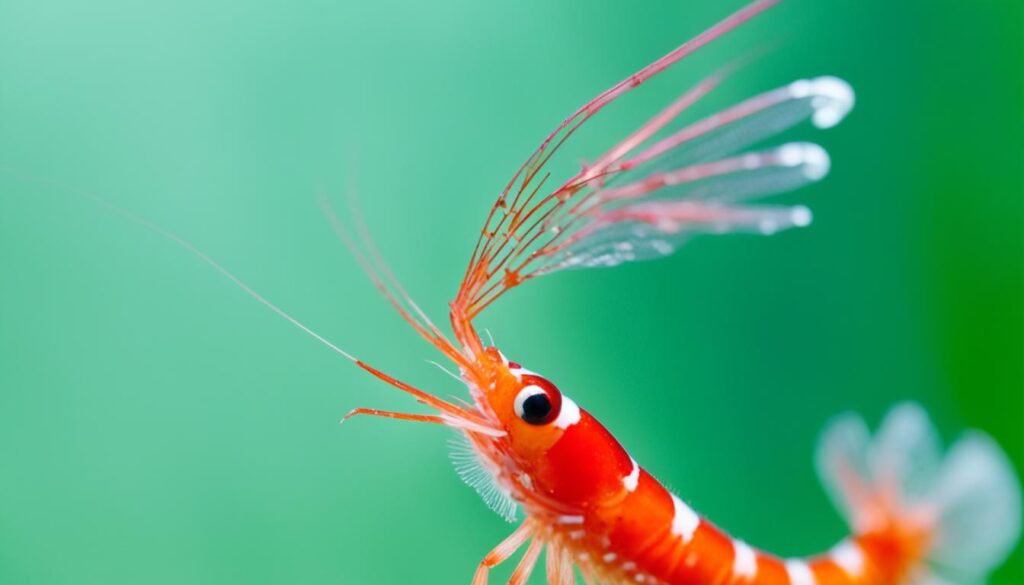
It’s important to know what a crystal red shrimp diet involves. This helps mimic their natural food in your aquarium.
These shrimp are omnivores. They normally eat algae and aufwuchs. But in tanks, you need to add to their diet to avoid missing nutrients. Offer them quality shrimp pellets, a variety of blanched vegetables, and sometimes frozen bloodworms for protein. This mix is vital for good crystal red shrimp care.
To keep their diet varied and balanced, control how much you feed them. Give small amounts daily or every other day. This makes sure they eat all their food quickly. It helps avoid waste and keeps the water clean. Here’s how to ration their food:
- Combine commercial shrimp food with natural algae.
- Add blanched veggies like zucchini, carrots, or spinach carefully.
- Give treats like frozen bloodworms or daphnia only sometimes. Too much protein is bad for them.
Always remove food they don’t eat right away to keep the water fresh. Feeding them too much is a mistake many make. It can raise ammonia and nitrite levels, hurting your shrimp.
Diet Component |
Frequency |
Amount |
|---|---|---|
Shrimp Pellets |
Daily |
As much as they can consume in 2-3 hours |
Blanched Vegetables |
2-3 times per week |
Small pieces |
Protein Treats |
Once a week |
One small piece per shrimp |
By understanding and following these feeding tips, your Crystal Red Shrimp will not only survive but flourish. Their vivid red and white colors will stay bright, and their health will be top-notch.
Tank Mates: Friends or Foes for the Crystal Red Shrimp
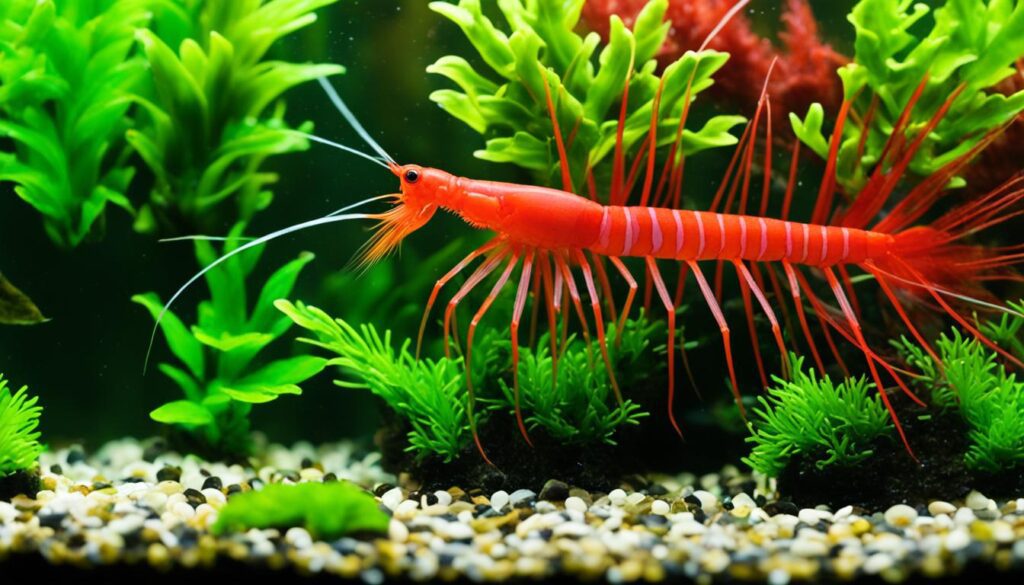
When picking crystal red shrimp tank mates, choosing peaceful species is key. These selections help avoid disrupting the breeding of these gentle aquarium dwellers. A calm, stable home is crucial for their breeding success.
Choosing Compatible Tank Mates
Finding the right companions is vital for a healthy aquarium. Some aquarists like adding diverse species. However, certain non-threatening snails and small shrimp forge peaceful relationships with crystal red shrimp. Creatures like nerite, mystery, and Malaysian trumpet snails are great since they don’t fight over food. Small filter-feeders such as Amano, bamboo, and vampire shrimp also suit well as they stick to themselves and avoid conflict.
When to Keep CRS in a Shrimp-Only Environment
At times, crystal red shrimp do best alone, especially for high-grade breeding. A tank without other species lowers disease risk and aggression. It also makes controlling water quality easier. This kind of environment is perfect for meeting the breeding needs of crystal red shrimp.
Species |
Compatibility with Crystal Red Shrimp |
Notes |
|---|---|---|
Snails (Nerite, Mystery) |
Highly Compatible |
Peaceful, no competition for food |
Filter-Feeding Shrimp (Amano, Bamboo) |
Compatible |
Keeps to themselves, low risk of stress to CRS |
Fish (Dwarf Cory Catfish) |
Generally Safe |
Avoid overpopulation to minimize stress |
Other Caridina Shrimp |
Use Caution |
Potential for crossbreeding and aggression |
Choosing whether to mix species with crystal red shrimp or not requires thought. Taking note of the potential tank mates’ behavior leads to a peaceful aquarium. This keeps your crystal red shrimp happy and healthy.
Crystal Red Shrimp Breeding Essentials
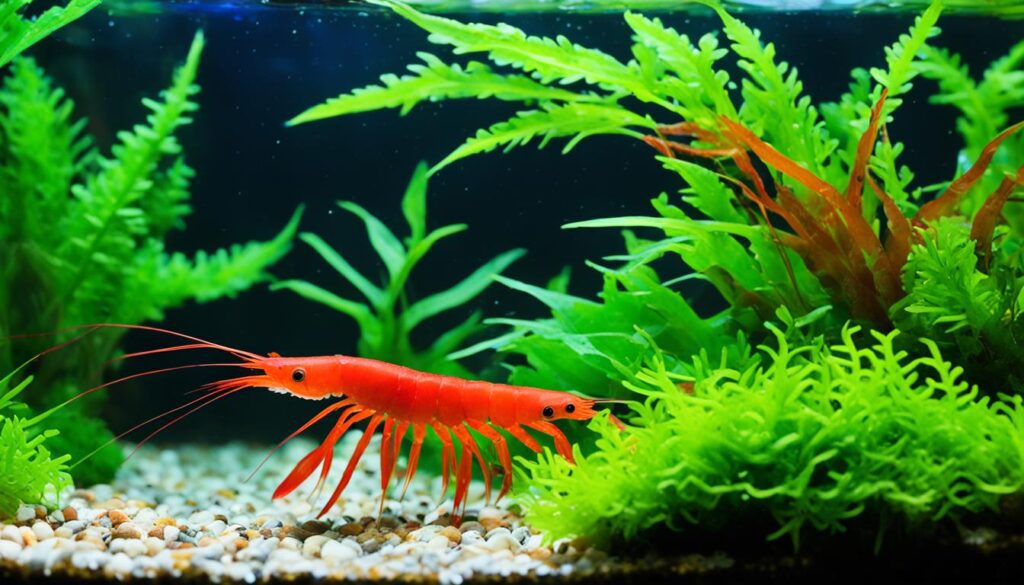
Starting with crystal red shrimp breeding means learning about their needs. These shrimp are beautiful but need careful attention. Understanding crystal red shrimp care is crucial to make the perfect place for them to breed.
Water quality is key for breeding crystal red shrimp. Keep the water between 70°F – 73°F (21-23°C) for their best health and colors. The water should have a pH of 5.5 to 6.5 and a GH of 5-6 dGH to help them molt properly.
To keep their environment stable, manage the KH between 1 – 2 dKH. This helps keep the pH level steady. Also, make sure the TDS is between 100-200 to protect their sensitive systems.
- The tank size should be 20-40 liters (5-10 gallons) to give them enough room.
- Use a sponge filter to avoid strong water currents that stress the shrimp.
- Adding plants like mosses and ferns helps keep the water clean and looks great too.
Breeding crystal red shrimp requires patience. Females can be spotted by their rounded bellies and will carry eggs for around 30 days. Once hatched, shrimplets need good water and powdered baby food to grow.
Keeping everything consistent is vital for crystal red shrimp care. Avoid big changes in the water. It’s best to change 10% of the water every 7-10 days to keep their home stable.
The aim is to mimic their natural environment. Doing this increases your chances of success in crystal red shrimp breeding. A clean, stable home is key.
Grading System of Crystal Red Shrimp
Exploring the world of Crystal Red Shrimp (CRS) is an engaging hobby. For breeders and collectors, knowing the crystal red shrimp grading system is vital. The grading ranges from C, which is the most common, to SSS, the top-notch. This grading looks at their color, how clear it is, and their patterns.
Higher grades like SSS have a stunning mix of white over red, making them very appealing. Such high-end shrimps can be pricey, with some crystal red shrimp for sale for as much as $750. These shrimps are considered as living jewels, attracting investments of $500 to $1500 for the most stunning ones. The higher the quality, the rarer and more valuable the shrimp.
The grading system shows a wide price and quality range, from the affordable C-grade to the exquisite SSS Mosura Crystal Reds. But, this system is just a guide, not a strict rule for their value. In the US, you can find A or B grade shrimp for $1 to $5, perfect for beginners. Special patterns like Hinomaru and Mosura stand out, showing evolution’s art on these shrimps. These differences in color and pattern highlight the shrimp’s marketplace value, catching the eye of breeders and hobbyists who aim to beautify their collections.
